
Posted on 03/02/2012 4:25:29 AM PST by Homer_J_Simpson


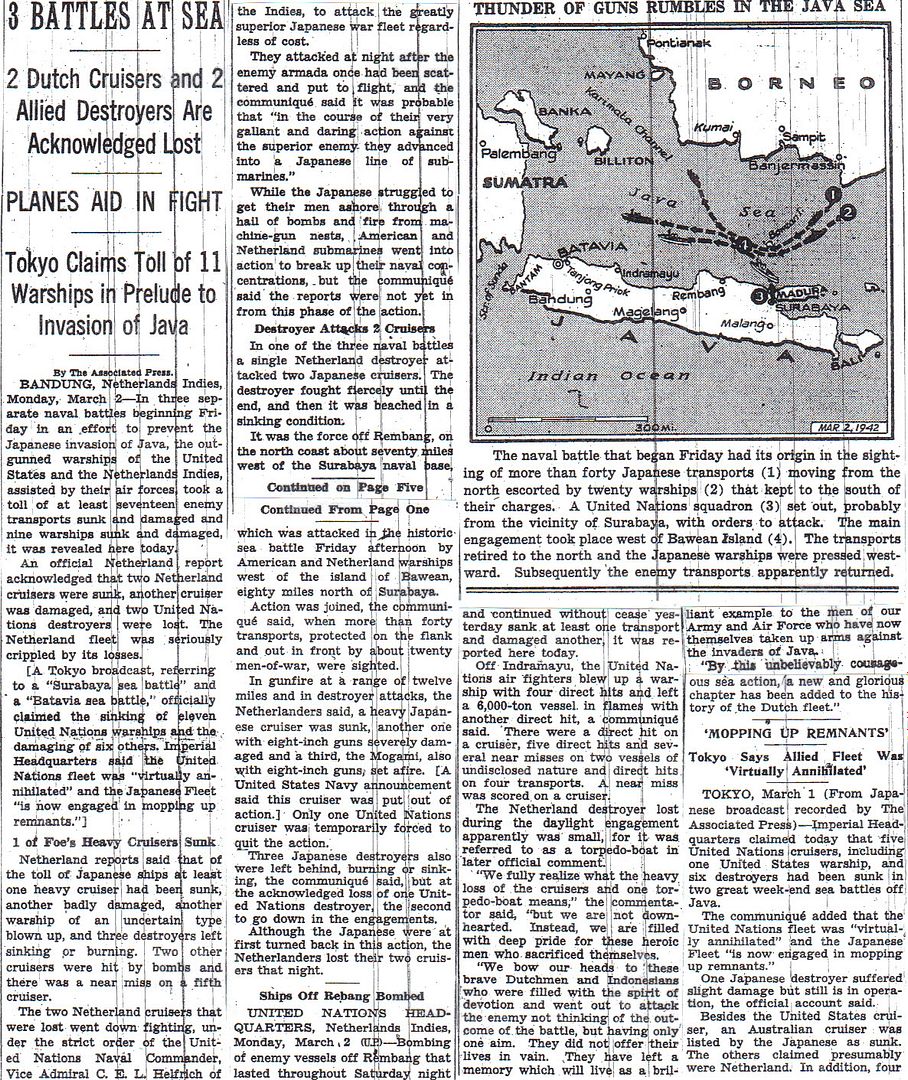
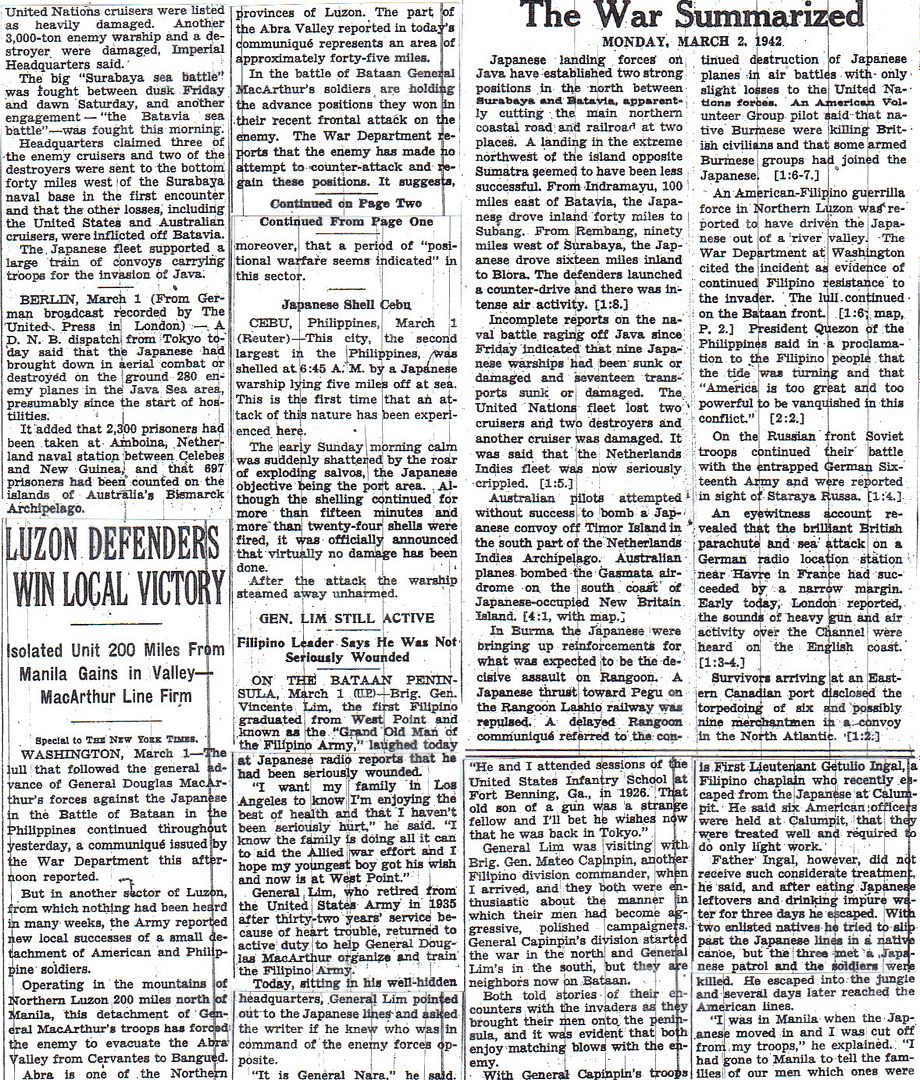
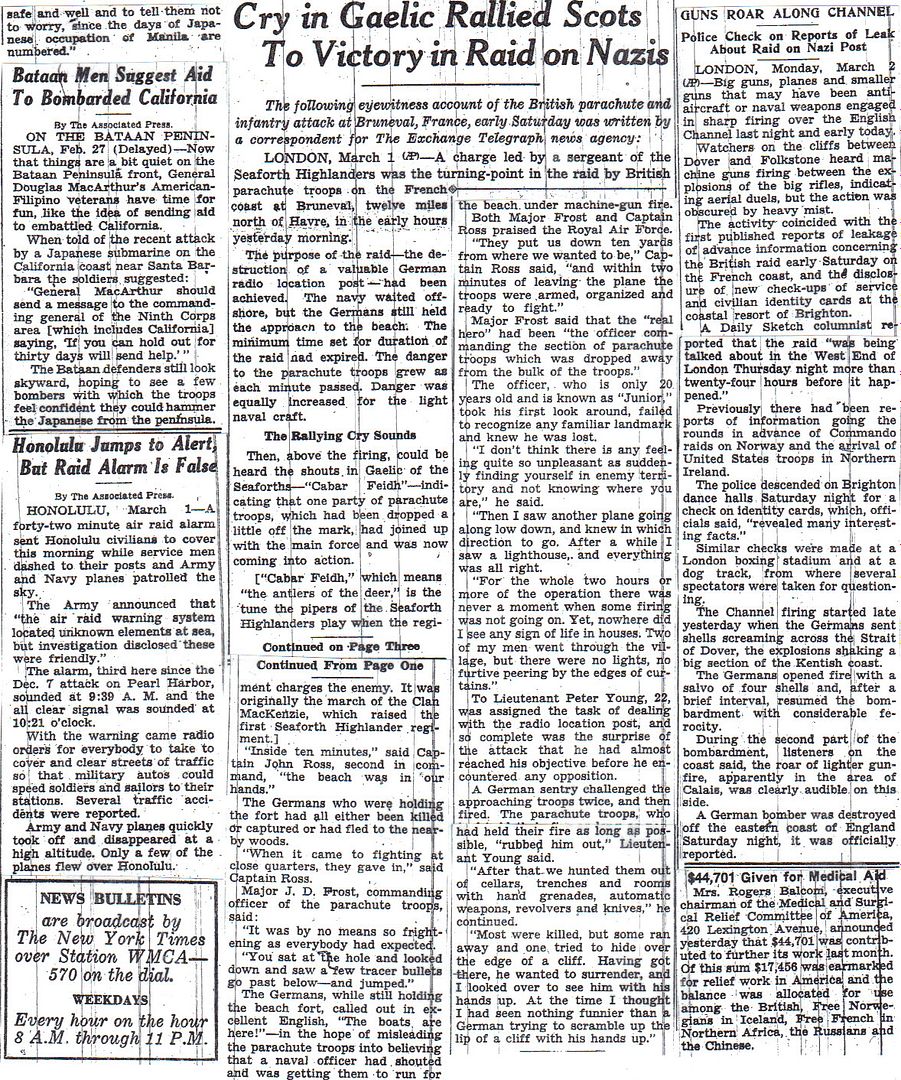
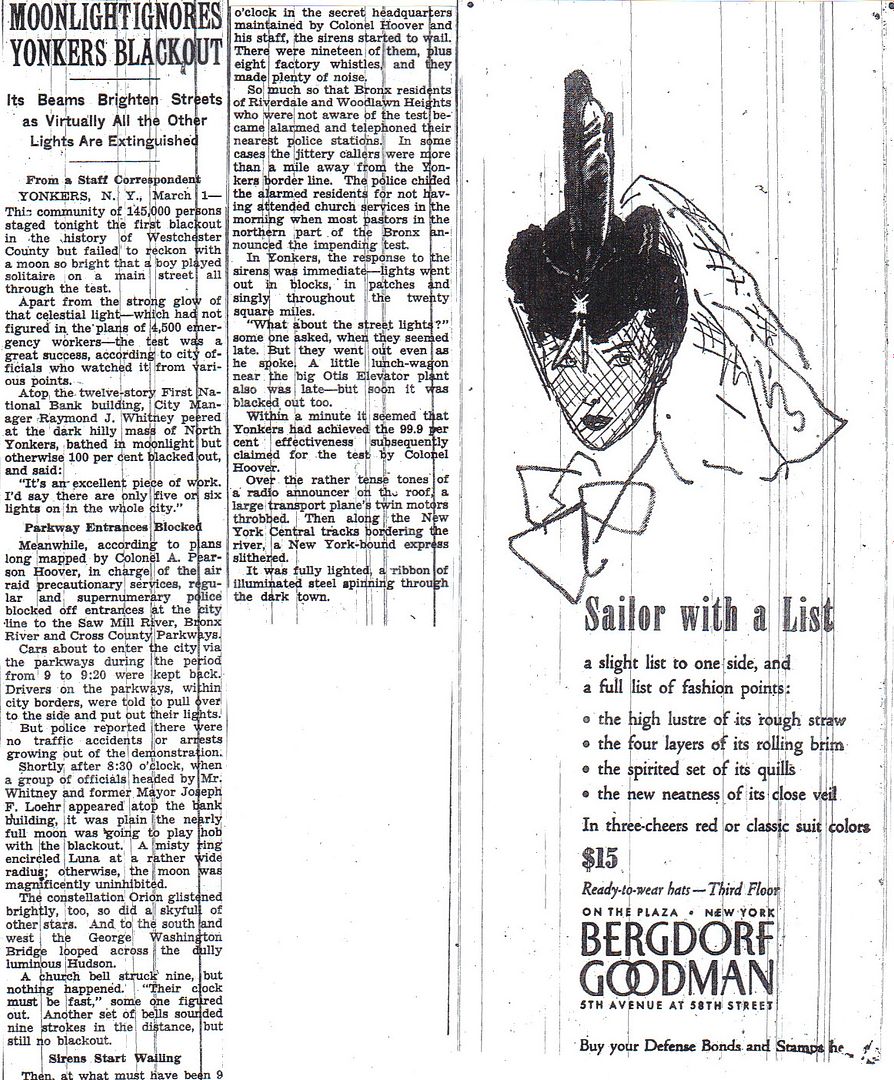

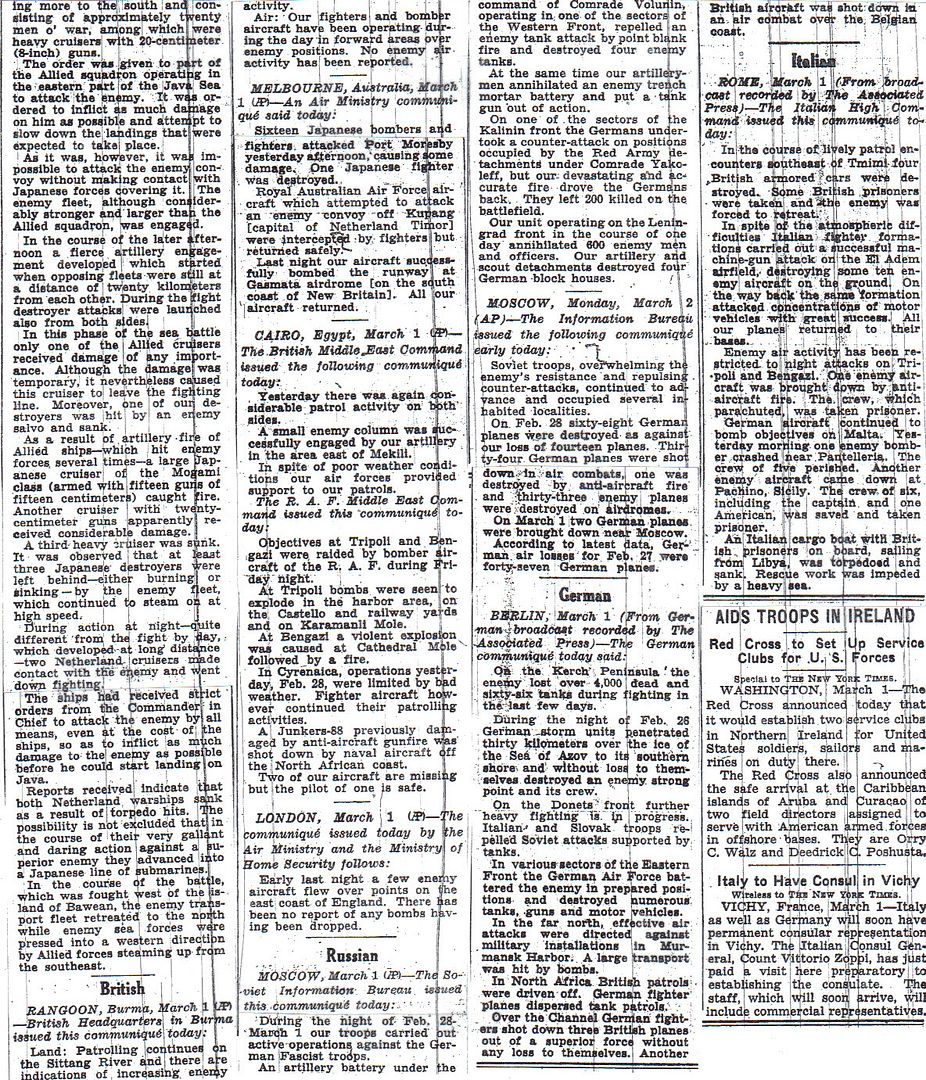
Invaders Advance – 2
3 Battles at Sea – 3-4
Luzon Defenders Win Local Victory – 4-5
Cry in Gaelic Rallied Scots to Victory in Raid on Nazis – 5
Moonlight Ignores Yonkers Blackout – 6
The Texts of the Day’s Communiques on Fighting in Various Zones – 7-8
http://www.onwar.com/chrono/1942/mar42/f02mar42.htm
Japanese advance in Philippines
Monday, March 2, 1942 www.onwar.com
Japanese General Homma arrives in the PhilippinesIn the Philippines... Japanese forces land on Mindanao. Japanese warships bombard targets on Mindanao, Ceo and Negros Islands.
In Burma... the Japanese troops cross the Sittang River in force.
In the East Indies... Batavia on Java falls to Japanese Troops
http://homepage.ntlworld.com/andrew.etherington/frame.htm
March 2nd, 1942
UNITED KINGDOM: The second U.S. Army increment (8,555 personnel) of the MAGNET Force, the movement of the first U.S. forces to Northern Ireland, arrives in Belfast in a 21-ship convoy plus escorts which sailed from Brooklyn, New York on 19 February. Among the arriving troops is the 34th Infantry Division headquarters and parts of the 133d and 168th Infantry. American strength in Northern Ireland on this date is reported as 10,433 (including 534 officers, 70 nurses, and 2 warrant officers). (Jack McKillop)
Destroyer ORP Orkan (ex-HMS Myrmidion) launched.
Escort carrier HMS Avenger commissioned. (Dave Shirlaw)
NETHERLANDS: Four RAF Bomber Command Bostons attacked ships off Den Helder without loss. (Jack McKillop)
GERMANY: U-185, U-520 launched. (Dave Shirlaw)
HUNGARY: The government breaks diplomatic relations with Brazil. (Jack McKillop)
U.S.S.R.: Minsk: The Germans shoot dead 5,000 Jews.
TURKEY: The government closes the Dardanelles to all ships without Turkish captains. (Jack McKillop)
BURMA: The Japanese continue to infiltrate westward between the Burmese 1st and Indian 17th Divisions and are swinging southwest on Rangoon, bypassing Pegu. (Jack McKillop)
NETHERLANDS EAST INDIES: The Japanese gain further ground in Java, where the Dutch are continuing to resist; the Japanese claim the capture of Batavia, from which Dutch Government has been forced to move to Bandoeng. Actually, a hastily organized Australian-Dutch-American-British infantry unit commanded by Australian Brigadier Arthur Blackburn, General Officer Commanding Australian Imperial Force Java, stops the Japanese 16th Army’s advance on Batavia, the island’s capital. (Jack McKillop)
Many ships are scuttled off Java to prevent them from failing into enemy hands but the Japanese Main Body, Southern Force overtakes fleeing Allied ships southwest of Java; heavy cruiser HIJMS Maya and destroyers HIJMS Arashi and Nowaki sink British destroyer HMS Stronghold; heavy cruisers HIJMS Atago and Takao attack what they initially identify as a “Marblehead-class” cruiser and sink her with gunfire; their quarry is actually destroyer USS Pillsbury (DD-227), which is lost with all hands in the Indian Ocean about 270 miles (435 kilometres) south-southeast of Christmas Island. (Jack McKillop)
In Surabaja, three ships are scuttled in drydock, the damaged Dutch destroyers HNMS Witte de With and Banckert and the American destroyer USS Stewart (DD-224). Stewart had entered the floating drydock on 22 February, however, she was inadequately supported in the dock, and, as the dock rose, the ship fell off the keel blocks onto her side in 12 feet (3,7 meters) of water bending her propeller shafts and causing further hull damage. With the port under enemy air attack and in danger of falling to the enemy, the ship could not be repaired and
demolition charges were set off within the ship, a Japanese bomb hit amidships further damaging her; and, before the port was evacuated on 2 March, the drydock containing her was scuttled. Her name was struck from the Navy list on 25 March 1942 and her name was soon assigned to a new destroyer escort, DE-238. Later in the war, U.S. pilots began reporting an American warship operating far within enemy waters. The ship had a Japanese bunked funnel but the lines for her four-piper hull were unmistakable. After almost a year under water, Stewart had been raised by the Japanese in February 1943 and commissioned by them on 20 September 1943 as Patrol Boat No. 102. She was armed with two 3-inch (7,62 centimeter) guns and operated with the Japanese Southwest Area Fleet on escort duty until arriving at Kure, Japan, for repairs in November 1944. There her antiaircraft battery was augmented and she was given a light tripod foremast. She then sailed for the Southwest Pacific, but the American reconquest of the Philippines blocked her way. On 28 April 1945, still under control of the Southwest Area Fleet, she was bombed and damaged by USAAF aircraft at Mokpo, Korea. She was transferred on 30 April to the control of the Kure Navy District; and, in August 1945, was found by American occupation forces laid up in Hiro Bay near Kure. In an emotional ceremony on 29 October 1945, the old ship was recommissioned as simply DD-224 in theUSNat Kure. On the trip home, her engines gave out near Guam, and she arrived at San Francisco in early March 1946 at the end of a tow line. DD-224 was struck from the Navy list on 17 April 1946, decommissioned on 23 May 1946, and sunk a day later off San Francisco, California, as a target for aircraft.
At Jogjakarta Airdrome, the last airbase on Java still occupied by the Allies, 260 officers and enlisted men are crammed aboard five USAAF B-17 Flying Fortresses and three LB-30 Liberators for the final flight to Broome, Western Australia. (James Paterson and Jack McKillop)
LOMBOK STRAIT: Submarine USS Sailfish (SS-192) torpedoes and sinks Japanese aircraft transport HIJMS Kamogawa Maru about 10 miles (16 kilometres) off the northeast coast of Bali. (Jack McKillop)
COMMONWEALTH OF THE PHILIPPINES: Four P-40s based on Bataan attack Japanese ships in Subic Bay, Luzon, with 500-pound (227 kilogram) bombs sinking an auxiliary submarine chaser. One P-40 is shot down and the other three are destroyed in crash landings. (Jack McKillop)
The rations of the U. S.-Filipino army on Bataan are reduced again, this time to one-quarter of the normal daily food allowance. The trapped troops supplement their diet with horse and water buffalo meat and even lizards. Disease is taking a heavy toll on the 95,000 men on Bataan and Corregidor — especially malaria, malnutrition and diarrhea. Many men are so weak they can hardly crawl to their foxholes and lift their rifles. (Jack McKillop)
Elsewhere in the Philippines, Japanese warships bombard Cebu and Negros Islands in the central archipelago and Japanese troops land at Zamboanga on Mindanao Island. (Jack McKillop)
NEW GUINEA: The Japanese Navy begins heavy air strikes against Allied bases in preparation for invasion of the Huon Gulf area. (Jack McKillop)
AUSTRALIA: The government declares war on Thailand. (Jack McKillop)
Minesweeper HMAS Glenelg laid down. (Dave Shirlaw)
U.S.A.: Admiral Ernest J. King, Commander in Chief United States Fleet, proposes that 353 square mile (914 square kilometer) Efate Island in the central New Hebrides Islands be established as a place “from which a step-by-step advance could be made through the New Hebrides, Solomons, and Bismarcks.” (Jack McKillop)
Regularly scheduled operations by the U.S. Naval Air Transport Service are inaugurated with an R4D Skytrain flight from NAS Norfolk, Virginia, to NRAB Squantum, Massachusetts. (Jack McKillop)
The Western defence Command issues a proclamation which designates the western halves of California, Oregon, and Washington, and the southern third of Arizona as a military area and states that all persons of Japanese descent are to be removed from this area. Through the month of March 1942, people affected by this proclamation are allowed to move to new homes of their own choosing outside the military area, and about 8,000 people in fact move outside the military area during the month. (Scott Peterson) More...
Destroyer USS Aulick launched.
Destroyer USS McKee laid down.
Submarine USS Kingfish launched. (Dave Shirlaw)
ATLANTIC OCEAN:
At 2047, the unescorted Gunny was torpedoed by U-126 about 400 miles south of Bermuda and sank within one minute. The ship had been missed at 1215 by a first torpedo. 13 survivors climbed on a raft, but had no food and water. The injured chief engineer died on the fourth day. On 9 March, Swedish MS Temnaren picked up the remaining survivors. (Dave Shirlaw)
The 3 days Java Sea battles were more of a disaster for the Allies than Pearl Harbor. The true nature of just how bad it was, was kept hidden until much later in the war.
5,000 Sailors killed, a dozen plus ships sunk, including an Aircraft Carrier/Seaplane Tender (U.S.S. Langley) and several cruisers, Java and it’s oil lost, and India, Australia laid bare to attack, with literally nothing left in theater to stop the Japanese.
The propaganda of the time downplayed the importance of the losses, when in fact, the exact opposite was true.
Filipino’s want to send aid to Kalipornia. lol.
The entire Allied campaign in South East Asia from December 8th through the fall of Burma was a massive disaster from beginning to end.
-Poor land commanders in the Philippines and Malaya.
-Lack of coordination between the services. (Both US and Commonwealth)
-Lack of coordination between the ABDA powers
-Inadequate Air Forces and poor use of them.
-Naval Forces thrown away piecemeal
The Japanese plan should not have worked, but outside of the Philippines it worked perfectly. They used their few advantages (morale, initiative, and air power) to hammer the Allies repeatedly and keep them off balance. Despite the fact that the Japanese were using barely enough forces to do the job.
The only bright spot was the Philippines, which held out longer than anywhere else, and would have held out even longer had MacArthur not screwed up their supplies.
Fortunately for us, 1942 was the last time a US or British forces would suffer such a comprehensive defeat.
(Yes, we lost at Kasserine Pass, but it was not a defeat on this scale.)
‘Hitler’s Pope praised for preventing their deportation to death camps

I worked for a man, who was Dutch Army, and was captured on Java. Spent 5 years in a Jap POW cage, best Engineer I ever worked for, absolutely unflappable. His son was killed in VN, excellent man.
-snip-
The only bright spot was the Philippines, which held out longer than anywhere else, and would have held out even longer had MacArthur not screwed up their supplies.
Two questions: First, if the Philippine land commanders were as you say poor, how then could the only bright spot in the Pacific have been in the Philippines? Second, how did MacArthur screw up supplies?
On the supply side there was the issue of his backing the enforcement of Filipino law regarding the transport of food stocks across province borders. This was even after he had called for falling back to Bataan. Tons of rice and other essentials were left behind because of that. At the government depot in Cabanatuan about 10 million tons of rice was left behind to be captured by the Japanese due to the enforcement of these laws.
Ok but under WPO-3, how many people were to be fed and for how long versus the actual numbers?
I must disclose that I've never actually had before me the actual full text of any WPO variants so, I go on my general understanding that WPO-3 called for sufficient supplies for 40K men to hold out at most 6 months.
Tons of rice and other essentials were left behind because of that. At the government depot in Cabanatuan about 10 million tons of rice was left behind to be captured by the Japanese due to the enforcement of these laws.
I don't dispute that a lot of food was left behind but if the amount was in exces of what was called for under WPO-3, why not leave it behind for the civilian population? Furthermore, MacArthur had only been commander less than 6 months and his orders were to execute Rainbow-5. Why had no previous commanders who were under WPO at least provisioned Bataan and the Manila Bay island fortresses with non-perishables?
I dare say that in mid to late Dec 1941 when MacArthur switched from Rainbow-5 to WPO-3, had the American's (and Filipinos) understood they would not be resupplied and that the enemy were little more than primal savages, the Quartermaster Corps would have supplied Bataan and the island fortresses accordingly.
The "Hitler's Pope" monniker came straight from Moscow and the left has obediently clung to it ever since.
Well, first of all MacArthur would have been in the wrong to go by Orange's supply requirements to the letter. He knew his force was far larger than the 43,000 men called for six months supply in WPO-3. Also, remember that some in the WPD felt that MacArthur would set the Filopino force up to be able to last even as long as 12 months. This is what makes abandoning items like that 10 million tons of rice all the more damning.
Even with that, he still did not have Bataan supplied with the amount of food stuff as outlined by WPO-3. In the first week of January, quartermaster assessments of food stores on Bataan were placed at 20 to 40 days depending on the item. Even if we assume that this was calculated using 80 to 90k people instead of the planned 43k it still puts the built up stocks on the pennensula at less than half of what was required by WPO-3. When G-4 gave this report to MacArthur, the bleakness of the situation prompted him to issue the half-ration order on January 5th. Maybe they should have moved that rice.
Of course, MacArthur would have liked to have moved these supplies after he got that report, but by then he had waited until it was too late to move the amount of supplies that he would have needed to even reach the WPO-3 requirements.
And again, him being a commander in that theater for only 6 months is no excuse. He had been there longer than any of the previous commanders and was well versed on the situation from the word go. He wasn't just dropped in the Philippines from a farm in Kansas, he was the man who already was in charge of training the Filopino Army, the only change was that he inherited the small American force too. Nobody knew the state of things on the ground better than him. But despite that he still failed miserably at supplying the men on Bataan.
The consequences of a failed strategy are always severe. This was no different on Luzon when it became apparent that the Japanese could not be defeated on the beaches per RAINBOW-5 and WPO-3 was placed into effect.
As for the supply situation, my understanding is that the increased number of men to feed in Bataan over what was called for in WPO-3 was known. What was unforseen were the additional 25K-35K civilian refugees and residents of Bataan that also ended up being fed out of USAFFE Quartermaster supplies.
On Dec 8, there were less than 1,300 officers and enlisted men in the USAFFE Quartermasters Corps serving the U.S. Army, Philippine Scouts and Commonwealth Army. This was about 75% understrength for what was generally regarded as the minimum number of men (4K) required to maintain efficient field supply for a force of 100K men.
Prior to Dec 1941, Brig. Gen. Charles C. Drake, the Chief Quartermaster in the Philippines issued a logistics report showing that at least 14 days under good conditions would be needed to get 180 days of supplies for 43K men into Bataan. As we know, the actual number ended up being closer to 100K soldiers and civilians.
Between Dec 8 and Dec 23, the principal quartermasters challenge was supplying dispersed forward positions under RAINBOW-5. On Dec 23, Brig. Gen. Richard J. Marshal, MacArthur's Deputy Chief of Staff notified Gen Drake that WPO-3 was in effect and that he had seven days to supply Corregidor and Bataan. At about the same time, the Philippine rail system ceased functioning.
The degraded transport system in part necessitated authorization being issued to requisition civilian vehicles. To help overcome issues of transportation and schedule, the withdrawal of supplies from forward areas into Bataan depended heavily upon the willingness of combat officers to transport their men and supplies (food, fuel and clothing), a willingness unequally shared.
When retreating forces also transported supplies, the choice of which supplies if any to transport was largely up to what happened to be available and preferences of individual officers and men.
Also, remember that some in the WPD felt that MacArthur would set the Filopino force up to be able to last even as long as 12 months.
That may have been the case but for the most part, supplies for the Commonwealth force had to come from stateside and funds were not made available by Washington in meaningful amounts until approx Sept 1941.
This is what makes abandoning items like that 10 million tons of rice all the more damning.
Contrary to popular portrayals, it's not as if these foodstuffs were sitting out there in U.S. Government depots but MacArthur somehow prevented their being used. Not acquiring millions of tons of rice from the Cabanatuan Rice Central warehouses, not transporting rice beyond the Province it was purchased in nor seizing other local foodstuffs were conscious political and humanitarian decisions by MacArthur.
Even with that, he still did not have Bataan supplied with the amount of food stuff as outlined by WPO-3. In the first week of January, quartermaster assessments of food stores on Bataan were placed at 20 to 40 days depending on the item.
Those meager stores came from field provisions rather than the reserve supplies requested by USAFFE in the summer of 1941 of which only 500K cans of C rations had arrived from Stateside by Dec 1941.
Even if we assume that this was calculated using 80 to 90k people instead of the planned 43k it still puts the built up stocks on the pennensula at less than half of what was required by WPO-3. When G-4 gave this report to MacArthur, the bleakness of the situation prompted him to issue the half-ration order on January 5th. Maybe they should have moved that rice.
Again, not moving the rice was a political and humanitarian decision.
Of course, MacArthur would have liked to have moved these supplies after he got that report, but by then he had waited until it was too late to move the amount of supplies that he would have needed to even reach the WPO-3 requirements.
And again, him being a commander in that theater for only 6 months is no excuse. He had been there longer than any of the previous commanders and was well versed on the situation from the word go.
I assume you meant his total time spent in the Philippines was longer than that of any previous commander.
He wasn't just dropped in the Philippines from a farm in Kansas, he was the man who already was in charge of training the Filopino Army, the only change was that he inherited the small American force too.
Except the Filipino regular army numbered only a few thousand and it's approx 100K reserve force existed largely on paper due to a variety of political factors in the Commonwealth and Washington.
Nobody knew the state of things on the ground better than him. But despite that he still failed miserably at supplying the men on Bataan.
In the summer of 1941 Gen. Drake submitted requisitions to the War Department for supplies sufficient to last 50,000 men 180 days. By Dec 8, 1941, only 1,000,000 gallons of gasoline and some 500K cans of C rations had arrived in Manila.
For further reading, see:
Brig Gen Charles C. Drake, "Report of Operations of Quartermaster Corps USAFFE and USFIP in the Philippine Islands, 27 Jul 41-6 May 42"
Stauffer, Aliv P., "United States Army in World War II ,The Technical Services, The Quartermaster Corps: Operations in the war against Japan",Center of Military History, United States Army, 1956
I don't think there is any proof that he did any of this for humanitarian reasons. He did short his troops on Bataan by doing that though.
That he supplied the 25K-25K refugees and residents of Bataan from the meager provisions is evidence for humanitarian motives. As for political reasons:
"When it became obvious shortly after the Japanese landings that Luzon might soon come completely under enemy control, the increasing objection of the Commonwealth Government to measures that might reduce the food available to the Philippine public under Japanese occupation handicapped further accumulation of food reserves. This objection was reflected in the frequent refusal of Headquarters, USAFFE, to approve the commandeering of food, even the seizure of stocks owned by Japanese nationals."Stauffer, Aliv P., "United States Army in World War II ,The Technical Services, The Quartermaster Corps: Operations in the war against Japan", Center of Military History, United States Army, (p9), 1956
Disclaimer: Opinions posted on Free Republic are those of the individual posters and do not necessarily represent the opinion of Free Republic or its management. All materials posted herein are protected by copyright law and the exemption for fair use of copyrighted works.